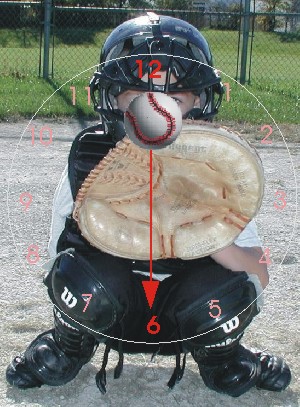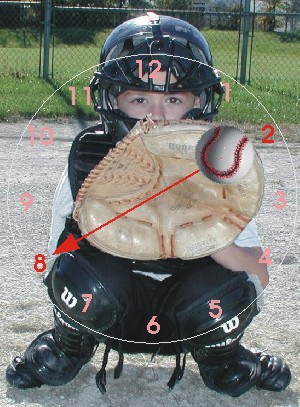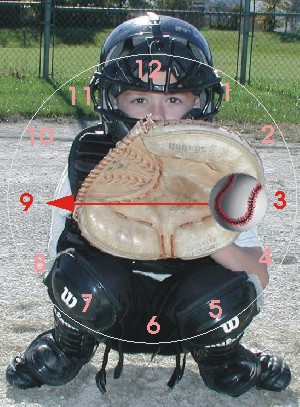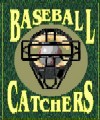|
One of the most difficult pitches for a catcher to handle is the
Change-Up because the ball does not follow the normal
path from pitcher's hand to catcher's mitt. Basically there are three kinds of change-up pitches:
Curve Ball, Slider,
and Cutter. All three are breaking balls.
When a breaking ball is called, the catcher
should cheat slightly
to the backhand side. The catcher must target the bottom of the zone. The
glove must be at the knees. Mentally, the catcher must assume the ball
will be in the dirt. Always be ready to block all balls in the dirt.
The Curve Ball is the slowest pitch and follows
the trajectory from 12 o'clock to 6 o'clock (see diagram at right) with little or no rotation. The curve ball can be set
up with a series of fast balls, especially high and outside ones.
When the pitcher gets ahead in the count and a breaking ball is called,
the catcher will set up on the plate and want the ball down, or in the
dirt. You want the hitter to chase the breaking ball and
get himself out. Again, be ready to block all balls in the dirt. |

|

|
The Slider is a change-up that moves from 2 o'clock to 8 o'clock (or from the catcher's
upper left to his bottom right) as shown in the diagram at left. This is an excellent pitch with two strikes on the
batter because he is generally looking to make contact and the slider is faster than a curve ball and mimics a fast
ball coming at him inside (right handed batter). This is also a good pitch for a left-handed batter who has been set
up with a couple of outside pitches because the ball appears to be another fast ball outside.
|
The Cutter is faster than a slider and may
be almost the same speed as a straight fastball. It is the one change-up that will really fool a batter who has been
setup with a couple of fastballs inside (to a right-hander) or outside (to a left-hander). The trajectory of a cutter
is from 3 o'clock to 9 o'clock as shown in the diagram at right (from catcher's
left to his right). The only danger is letting the ball get too high in the
strike zone. It should be targeted/thrown to the bottom of the strike zone. If it is targeted/thrown correctly and the
batter does get wood on it, the result will generally be a foul ball.
|

|
The battery needs to practice change-ups (breaking balls) more than any other pitch. They can be tricky to throw
and to receive. The pitcher is not throwing to a target but rather to the starting position of the trajectory which
will end up at the target (catcher's mitt). The catcher should expect that the ball will end up in the dirt and, thus,
should be ready to move his mitt from the target position to the ground to capture the ball.
For a left-handed throwing pitcher the above clock faces will be reversed. That is a
slider will move from 10 o'clock to 4 o'clock and a
cutter will move from 9 o'clock to 3 o'clock. Catching a lefty's change-ups
means that the catcher will have to be alert to balls in the dirt that will spin leftwards away from him. That means that
the catcher will have to cheat slightly to the fronthand side.
When the pitcher is behind in the count, the catcher should set up
on the plate and target the bottom of the zone. In this case the catcher wants a
breaking ball thrown for a strike within the zone.
An important tip to the pitcher and the catcher; if you are going
to miss, miss down and toward location. You won’t get hurt if you miss
down. However, if you miss up in the zone, bad things will happen.
| 

